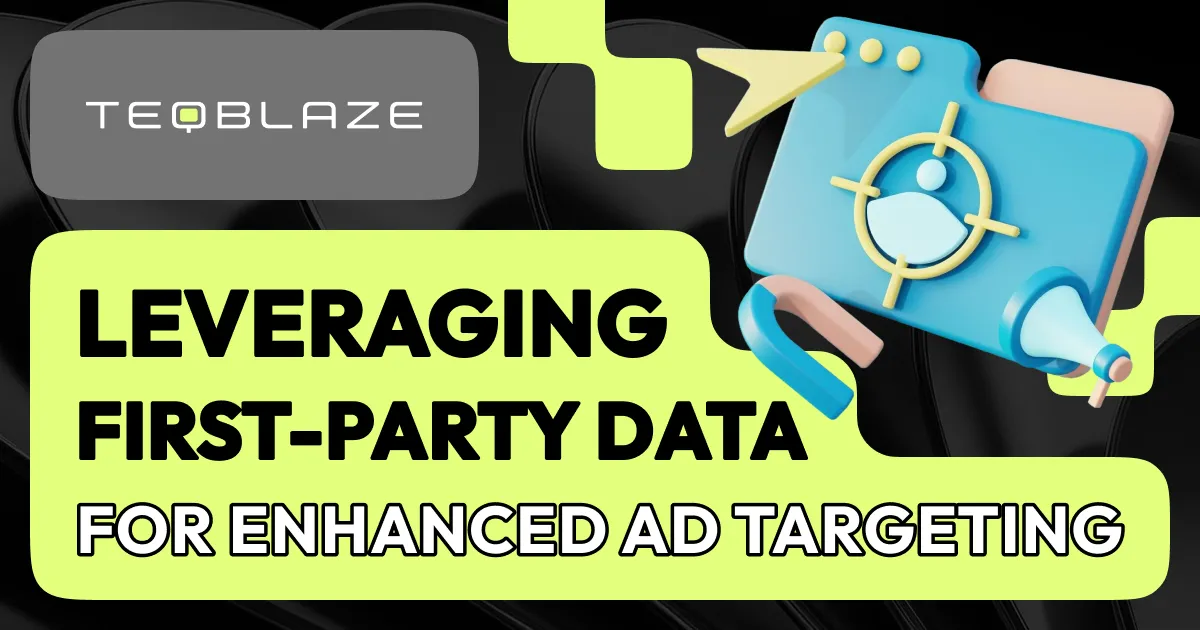Privacy is a significant concern in the modern domain of programmatic advertising. This trend leads to the decline of third-party cookies. Once such cookies were essential for marketing but nothing is constant. As traditional targeting methods become less reliable, first-party data becomes a powerful solution for brands aiming for precise targeting.
In this article, we explore the benefits of first-party data, the key principles for using it, and useful tips on how to use it properly. We’ll dive into the benefits of using data collected directly from your audience, compare it with third-party data, and provide actionable strategies to maximize its impact. So, let's dive into the concept of first-party data and its essentials for digital marketing.
What is first-party data in marketing
To start off, let's define first-party data. It is the information a company collects directly from its customers. In most cases, such data is retrieved from owned channels, such as websites, apps, email interactions, purchase history, and media platform interactions. Such information is gathered with user consent, which makes such data more privacy-compliant. In addition, such information is extremely relevant to personalized marketing. Businesses can use first-party data to understand customer behavior and enhance their targeting practices. Overall, the reliance on first-party data allows brands to build stronger relationships with customers while maintaining compliance with evolving data privacy regulations.
Benefits of first-party data for programmatic advertising
First-party data brings many benefits to marketing campaigns. Here are the most significant benefits of such an approach for programmatic advertising campaigns.
Enhanced data accuracy
First party data in programmatic advertising comes directly from customers who willingly share their information. Such direct interactions ensure higher accuracy of data compared to third-party data. In such cases, consumers actively provide this data, often as a result of a particular motivation. As a result, data is more precise, bringing marketers a better understanding of the target audience. This leads to improved campaign performance and better decision-making.
Highly targeted advertising
First-party data allows marketers to create highly refined audience segments based on demographics, behaviors, and interests. This precision enables businesses to deliver personalized ads to consumers who are most likely to engage. Such an approach also allows companies to refine their bidding strategies and optimize ad placements. As a result, businesses can achieve better conversion rates in programmatic advertising.
Improved analysis of customer lifetime value (CLV)
As has already been mentioned, first-party data allows businesses to gain deeper insights into customer behaviors. In particular, such information helps marketers understand customer purchasing patterns, retention rates, and spending behaviors much better. Based on such insights, marketers can understand average order value, the duration of customer lifecycle, and loyalty patterns. This, in turn, allows brands to improve their retention strategies to build long-term customer relationships.
Comprehensive customer journey insights
Understanding how customers interact with a brand at different touchpoints is crucial for optimizing marketing efforts. With first-party data, companies can map the customer journey across key stages, developing a more efficient sales funnel. By analyzing customer behavior during such stages as awareness, consideration, and decision, companies can establish more efficient engagement strategies for their customers.
Competitive advantage
It is also important to mention that 1st party data programmatic advertising can offer businesses unique advantages. While third-party data is accessible to multiple businesses, each set of first-party data is unique. As a result, marketers can develop exclusive marketing strategies based on detailed customer personas. At the end of the day, a business that relies on unique market data is very likely to outperform competitors that rely on generic information.
Unmatched personalization
First-party data empowers brands to deliver highly relevant, personalized experiences. A well-organized first-party data programmatic advertising strategy includes tailored content, recommendations, and promotions that resonate with their audience. It comes as no surprise that such precision and personalization help companies engage clients more effectively.
Key sources of first-party data for advertisers
A lot has been spoken about the value of first-party data. However, where do businesses usually collect it? Various data sources, ranging from website interactions to social media activity, help brands gain insights into how consumers interact with their business online.
Online and offline CRM data
Customer Relationship Management (CRM) systems store valuable information. In particular, such solutions provide email addresses, purchase history, and contact details of the clients. Marketers can integrate a CRM with an advertising platform to launch a continuous stream of first-party data for programmatic campaigns.
In this regard, it is important to distinguish the two main types of CRMs:
Online CRM (cloud-based) that offers remote access to client data and real-time updates
Offline CRM (server-based) that provides enhanced data security but requires IT maintenance.
By choosing the right system, you can establish efficient data collection and optimized ad targeting.
Survey responses
It is a more traditional way of collecting customer data. It was relevant even during the times when programmatic advertising did not exist at all. Various surveys and polls can provide marketers with direct customer feedback. This property makes them a valuable source of first-party data. Honest responses from potential clients can be used for audience segmentation, remarketing, and personalized ad campaigns.
Newsletter & subscription sign-ups
Encouraging users to subscribe to newsletters or exclusive content is an effective way to collect first-party data. This approach also offers such bonuses as the ability to keep the brand's audience informed about promotions and updates. Newsletters also help companies build trust by allowing consumers to opt-in for targeted advertisements.
Website analytics & purchase behavior
Here is one of the most common sources of 1st party data in programmatic advertising. Marketers review user behavior on a website to get deep insights into what content, products, and services attract the most interest. Analytics tools help identify user journeys, from initial visits to final conversions, enabling brands to optimize ad spend and refine marketing strategies. Another important data point is a client's purchase history. It helps advertisers craft personalized campaigns based on preferences and shopping habits.
Activating first-party data in ad targeting
Now, let's proceed with some practical tips. The workflows in programmatic advertising may differ drastically. However, these are some valid steps and practices that will help you collect different types of first party data from client interactions. Let's explore the key ways to leverage first-party data for enhanced ad targeting.
Audience segmentation for precise targeting
With first-party data, advertisers can segment their audience based on user behaviors, demographics, and purchase history. A quality targeting strategy requires marketers to categorize audiences into distinct groups. These are some common segmentation strategies:
Behavior-based segmentation: Users are targeted based on browsing history, product views, and abandoned carts.
Purchase history segmentation: With this approach, marketers can identify frequent buyers, high-value customers, and first-time shoppers.
Segmentation by demographics: In this case, marketers target groups based on age, location, and income levels.
Personalized ad campaigns
With first party data in marketing, companies can reach each buyer as a separate individual with one's specific preferences. Such an approach is applied in different advertising channels:
Programmatic advertising: This approach serves highly relevant ads in real-time based on users’ past interactions with the brand.
Social media campaigns: In this case, marketers create a community of lookalike audiences with similar interests across social media platforms.
Email marketing: This approach focuses on personalized subject lines, product recommendations, and promotional offers based on the user's past purchases.
Dynamic ad optimization
With first-party data, advertisers can launch dynamic ad creatives. Such campaigns can automatically adjust based on user response and preferences. In this case, key tactics include:
Product recommendations: Displaying products similar to those previously viewed or purchased.
Localized messaging: Using the user's geographical location to adjust campaigns.
AI-driven optimization: Relying on AI-powered algorithms to test different creative variations and determine the most effective messaging.
Retargeting & cross-channel integration
Retargeting is one of the most effective ways to re-engage users who have interacted with a brand but have yet to convert. By using 1st party data, businesses can reconnect with such users with such practices:
Display retargeting: Showing tailored ads across websites and apps to users who visited specific product pages.
Email retargeting: Sending personalized follow-up emails based on past website visits or abandoned shopping carts.
Cross-device targeting: Delivering consistent advertising experiences across mobile, desktop, and tablet devices.
Rely on TeqBlaze as your trusted partner
To leverage first-party data properly, you must rely on the most experienced adtech companies. One such company is TeqBlaze. For example, we helped a U.S.-based marketing company build its custom demand-side platform (DSP) that can be used for managing diverse programmatic advertising campaigns. Developed within a one-month deadline, this solution leverages OpenAI functionality to process various user data for enhanced campaign optimization. As a result, the customer managed to boost their ROI dramatically.
We also helped a notable digital advertising company that manages ad delivery for over twenty web publishers through a Master Channel Account. Our team provided them with a white-label DSP and SSP bundle that enhances campaign precision by using the most relevant user data. This solution helped the customer reach market autonomy and enhance their revenue streams.
Our expertise extends beyond these examples. We can consult you on the most urgent digital advertising topics and help you develop top-notch adtech solutions that will help you collect and leverage the most precise first-person data.
Final word
First party data programmatic advertising is an essential asset for businesses looking to enhance ad targeting while maintaining compliance with evolving privacy regulations. With direct customer insights, companies can achieve greater personalization, improve audience segmentation, and improve their marketing strategies. As third-party cookies phase out, the shift toward first-party data is not just a trend but a necessity for brands aiming to stay competitive in the digital advertising landscape. Partnering with experienced adtech firms like TeqBlaze ensures that businesses can effectively harness their data. Contact us to find ways to leverage excellent first-party data.

 Grigoriy Misilyuk
Grigoriy Misilyuk Rostyslav Faivinov
Rostyslav Faivinov






